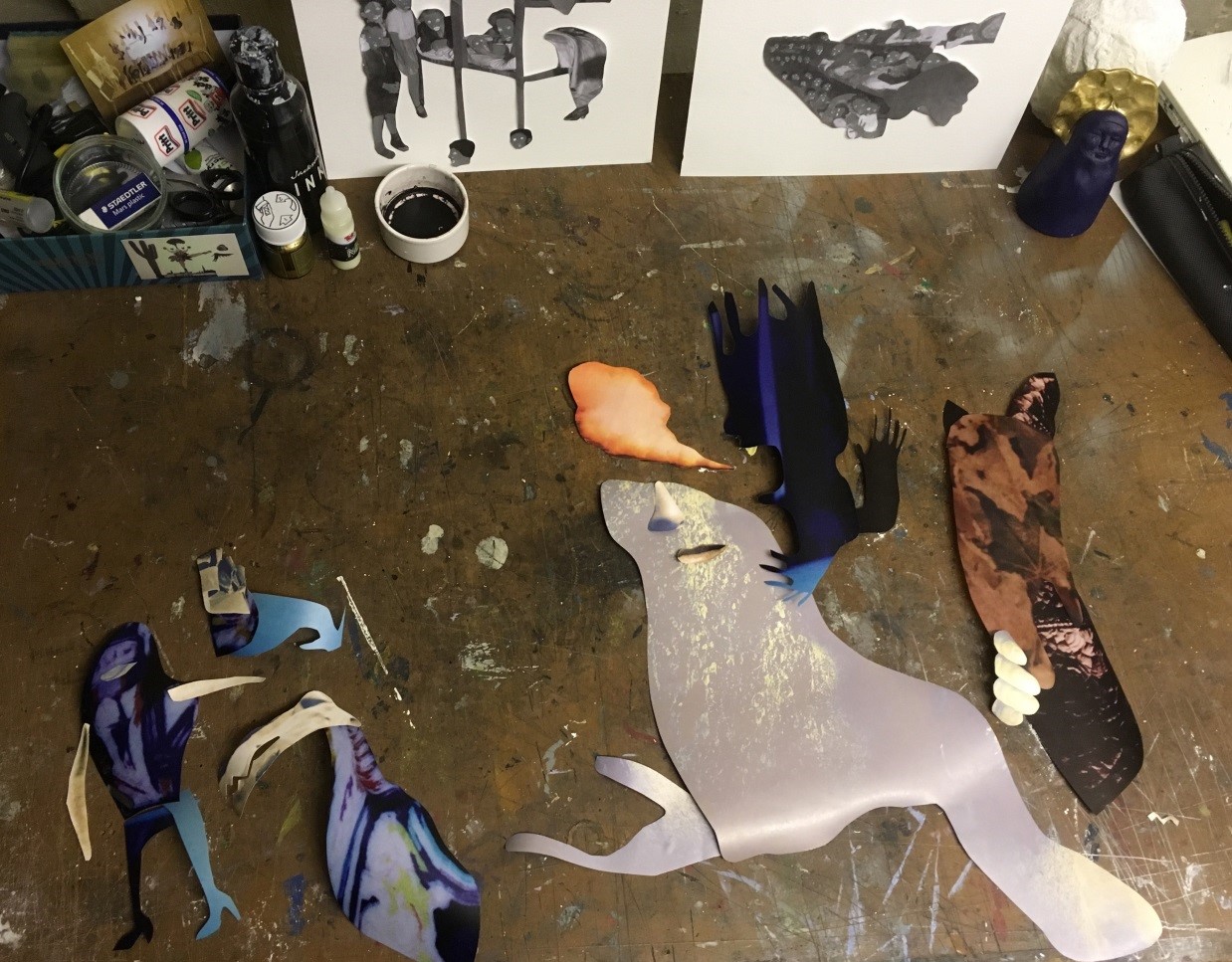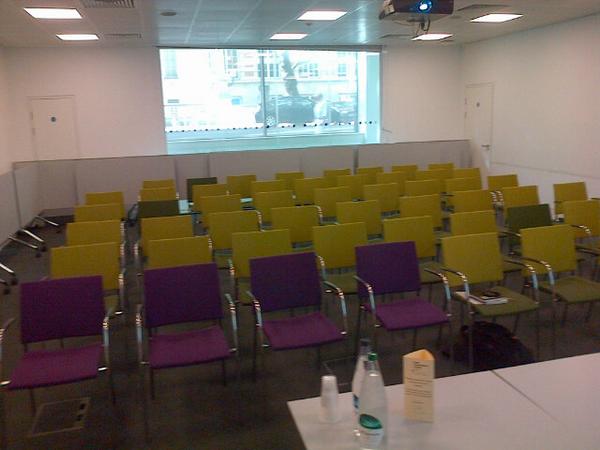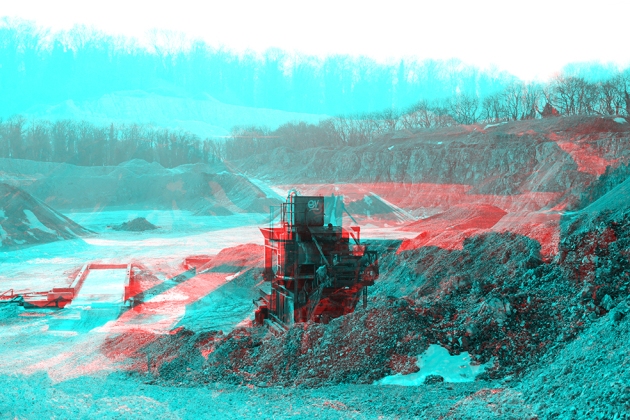
Back in the bunker
So, I’m standing in the sparse canteen, sipping a glass of something fizzy. My neighbour turns to me and we exchange names. Then there’s a pause. She looks at me quizzically. ‘You’re Luke Bennett? You’re Luke Bennett?’ She looks like her mind is trying to catch up. There’s something about me that apparently doesn’t fit my name. She’s a cultural geographer, we’re in York Cold War Bunker and I’m amused. This isn’t the first time this has happened.
I have two arms, two legs, stand just over six feet tall and have no distinctive features. My once very dark brown hair is starting to look like I’ve been in a fight with a sack of flour. I’m middle aged and dress like it. I’m not sure what she was expecting me to look like (or be like), but from the work of mine that she’d read it seemed that she was expecting something different.
I then gleefully enhanced the mind-warp effect by explaining that I’m not a card-carrying geographer, but instead a slightly wayward environmental lawyer who spends his daylight hours teaching real estate students. To add the knockout blow I then introduced my SHU colleague, Sarah (a chartered surveyor) and explained how we are currently working on a project that explores the role of estate managers and estate agents within the ROC Post network, and that we’re spending most of our time looking at old Air Ministry estate management files, Land Registry title records and landowner’s files. We think (and our bunker-acquaintance agreed) that this focus on the day to day forming, holding-together and dissembling of the ROC Post network is an angle that’s not been done before, and that it is worth doing.
Since finishing my PhD journey last month I’ve had lots of people coming up to me asking me one or both of the following: ‘So, what’s your next project then?’ and ‘so, are you going to leave SHU now?’. In reply to the second question is: ‘No, I’m not’ and the answer to the first is more complex. My PhD portfolio took me up to work published in 2013. I’ve carried on working on further projects since, and still have some of these in hand (and others in prospect). So, in that sense it’s just a case of keeping on going. I’m still interested in the same fundamental question (how we make, manage and encounter the built world through discursive-materialities) and I still prefer investigating this through case studies. Maybe there has been some subtle refocussing since 2013 – trying to pull the strands more closely together, and so recent work has tried to pull the legal geography and ruins stuff together (and I’m working on a very exciting funding bid on that, more on that when it’s not secret). Maybe also I’m getting a bit more historical in my focus – I’m finding the lure of archives an appealing one. I miss my days spent trawling through stacks of documents as a lawyer, looking for a smoking gun.
But I can’t seem to escape the bunker. My bunkerology is continuing via the book project (now entitled ‘In the Ruins of the Cold War Bunker: Affect, Materiality and Meaning-making), which has been commissioned by Rowman & Littlefield International, and I have 12 contributors inputting to that.
As I strolled around No. 20 Group (York) ROC command bunker last night, all sorts of future angles proliferated. One study that I’d attempt, if I had more time and was even more dissident, would be on bunker-pooh. Yes, bunker-pooh. There’s a ‘sewage ejector’ machine in the York bunker. The sign indicated that this would – if the drains became blocked – expel excrement from the shelter, presumably at quite some speed and force. That certainly summons a strange image and related set of questions (was that machine the culmination of a technician’s life’s work?; was there a committee that identified the need for a shit-cannon?). I’ve tried (and failed) to encourage a fellow academic bunkerologist to write up his findings on problematic pooh at his bunker. He’s far more serious-minded than me though. His research identified that his bunker had revealed itself to the surrounding, outside, everyday world precisely because of its noxious emissions. That bunker’s existence wasn’t ferreted out by valiant oppositional detective work. It was disclosed by wayward excrement.
Anyway. You get the idea – wandering around a bunker you get to encounter all of the technology and logistics of basic human existence. The bunker thus becomes organic, in that it must have mechanical organs to duplicate/aggregate its human denizens’ bodies. It is like walking around inside a body.
The other thing (in a related, but non-scatological vein) that drew my attention was the bureaucratic architecture of resource depletion. This bunker was stocked for 30 days of operation. The commanding officer had a chart on the wall on which he would meticulously log how much food and other consumables were left. When these ran out the bunker’s role (and operability) would expire, along with its occupants too, unless they chose to leave and take their chances in the post-apocalyptic terrain beyond the entrance hatch. This place only offered temporary survival, and had no provision for beyond that. It was a place of pure function and duty (to co-ordinate ROC Post fall-out observations).
Dark Real Estate
Earlier this week, ‘Becoming Spatial Detectives’ my synoptic review of legal geography (co-authored with Antonia Layard) was published in the journal Geography Compass (it’s available open access here). If you want to know how we’d like legal geography to evolve, or you are curious about shipwreck cannibalism, we think it’s well worth a read.
By exploring the legal geography direction, and in other projects examining the fate of particular place-formations, I’ve found a way of re-embracing my law, and also ‘land management’ sides, but doing so within a context that is productive for the existing geographically-inclined topics that I’ve been exploring to date. Maybe such a conjunction needs a name, with Carolyn Gibbeson (another hybrid surveyor/cultural geographer) we’ve come up with ‘dark real estate’. My work has been on bunkers, Carolyn’s is on abandoned mental asylums, and a few years ago we wrote jointly about cemeteries. That makes it all sound like murder-house studies (an emergent sub-genre in the US), but I think its wider, less about studying stigma and more about examining redundancy and the awkwardness of afteruse for properties of a type that are too big (asylums) or too small (ROC Posts) to be either easily repurposed or erased. The intended analogy is with ‘dark tourism’ studies, but I’m also thinking of that more technical sense of ‘occult’ (occluded, hidden, not noticed). In some ways ‘grey real estate’ would be better (in terms of linking to ‘studies of everyday life’), but just as ‘dark real estate’ sounds a little too gothic, ‘grey real estate’ sounds self-defeatingly dull. So, ‘dark’ it is, for now at least.
Each of us (often separately, occasionally simultaneously) hangs out with geographers (and our work often makes more immediate sense to geographers and the wider humanities than to the econometrics dominated world of ‘real estate research’). We use qualitative research methods and cultural geographic concepts, and yet we’re also addressing questions that are (or we think should be) central to studies of how types of buildings (and the places that they form) persist (or don’t).
In pursuit of this question, I also seem to have fallen into the company of contemporary archaeologists recently (those who apply archaeological methods to the physical remains of recently abandoned places). I’m trying to work through the relationship between their near-present focus on built environment heritage, and our dark real estate near-past focus on passage of buildings through use-phases (and their ultimate arrival at redundancy). I’m speaking on this at the Contemporary and Historical Archaeology in Theory (CHAT) conference in Sheffield in November, so it will be interesting to see how that goes, particularly as I will be building my talk around the (archive based) ROC Project.
Multiple faces
To return to the beginning.
Doing ‘dark real estate’, places us at the boundary between two (or more) very different disciplines, slightly orphaned, but also strangely empowered because our vantage point lets us be in both worlds, and to mediate between the two. This inevitably entails a degree of active management of the presentation of self (as Erving Goffman would put it). We adjust our register, and present slightly different faces as we engage with each audience. This is much easier to manage in hyperspace though (i.e. through this blog). In face to face encounters it seems to trigger those uncomprehending looks and someone frantically strives to pigeonhole us into one or other identity. It’s hardest when the diverse communities are all in the same room at the same time – and you are trying to address them all at once.
In my last post I wrote about this selectivity of ‘faces to the world’, and of how we never show (nor indeed ever could show) all of the versions of ourselves to the world in one go. We code-switch as circumstances require. This links to a key argument in my contribution to Tina Richardson’s edited collection Walking Inside Out: Contemporary British Psychogeography, published earlier this week. My chapter is called ‘Incongrous steps toward a legal psychogeography’. In being part of this collection I align to a more arts and humanities milieu in style and methods, but my aim in doing so is actually to fly the flag for an attentiveness to the constitution of the built environment, the actual laws (rather than the ‘social’ laws that Guy Debord thought psychogeography could uncover). To achieve this (and to subvert the existing legal geography canon in doing so along the way) I take a passage from Nick Papadimitriou’s Scarp (2012) and apply détournement to it – making Nick’s words work for me, taking them for a walk in a different direction (Nick and I have corresponded and he’s told me that the two passages my chapter works with were ‘passing thoughts’ in his text, so it’s me not he who builds them toward significance). Anyway, here’s an excerpt from my chapter:
“…Papadimitriou takes us – early on in his traverse along the escarpment of what is now the lost county of Middlesex – to ‘Suicide Corner’, a stretch of the A41 snaking out its path North West of London. He recounts for us a succession of fatal car crashes, and of the people, creatures and other matter caught up in each event that occurred there. In doing so he draws forth isolated incidents, from the pages of long forgotten local newspapers and memory, activating these incidental archives in order to show a reverberation of these events within the landscape itself.
At one point in his rumination Papadimitriou figures an anonymous “civil engineer working for the transport ministry” who “through eyeing the scraggy wood just to the north of the farmhouse, sees only camber, curve and how best to extend the planned M1 extension over this high ground from its present terminus” (Papadimitriou 2012, 20).
Papadimitriou captures in this passage how the task-orientated gaze of the engineer sees the topography as a set of logistical challenges, a puzzle to solve as he works through in his mind’s eye the most feasible path for his roadway. Papadimitriou’s description seeks to show how all other sensory inputs are blocked (or discarded) as irrelevant to this man’s purpose. He is standing there for a reason. He is harvesting the landscape for what he needs today. This applied gaze foregrounds certain features, and backgrounds all else. This spectator is in the engineering-professional equivalent of “flow” (Csikszentmihalyi 2008 – for whom flow is an optimal immersion in the moment, marked by both physiological and psychological change). He is portrayed as at one with his task, the landscape presenting to him as a specific “taskscape” (Ingold 1993, 1570) – the very perception of a landscape being formed by the requirements of the task to be carried out there.
And yet, Papadimitriou then importantly shows how even that intent focus is vulnerable to undermining by the assault of the disregarded ‘background’, as an irresistible reverie – or least a momentary noticing of other things – takes hold:
Momentarily distracted from his plans by the chirping of some unnamable night bird, he looks eastwards across the brightly lit Edgware Way, towards the high ground at Edgewarebury. Perhaps moved by some spontaneous memory of childhood holidays spent in the New Forest, his imagination lingers in the woods and fields like a slowly drifting plant community and then dissolves into ditches lined with black waterlogged leaves – a residue of previous summers – and the ghosts of dead insects (Papadimitriou 2012, 20).
I then chart how this connects to the material-affective turn in cultural geography (suggesting that it’s time to recognise psychogeography’s affinity with Non Representational Theory (Thrift 2008)) and then try to switch psychogeography’s attachment to an escapist ‘reverie’ back upon itself, thus:
“But, there is more work to be done. Whilst the landscape poet can happily leave us with a Romantic resurgence of ‘nature’ overwhelming instrumentalist man, psychogeography’s embrace of incongruity can – and should – be taken further. Psychogeography should equally be able to show how the workaday preoccupations of an instrumentalist science can invade a thought-stream of more affective purpose, showing how the ‘straight’ world reasserts itself, barging itself back to the foreground, in short how it re-colonizes consciousness and gaze. So for example, Papadimitriou’s engineer’s reverie – his tumble back to environment related childhood memories – is fleeting, itself inevitably undermined by the ‘day job’ returning to his consciousness, the ‘real world’ bringing him back down to earth, and back to the prosaic task in hand, as he turns away from reminiscence and resumes his survey of this countryside and its future road course.”
I then go on to suggest that Legal Geography’s recent interest in the pragmatics of everyday engagement with (and production of) place could provide the avenue for fulfilling Debord’s prescription that:
“Psychogeography could set for itself the study of the precise laws and specific effects of the geographical environment, consciously organized or not, on the emotions and behavior of individuals.” (Debord, 1955).
Elsewhere I try to outline the methodology that lies at the heart of this disciplinary-blurring intent (lining it to James Clifford’s (1988) ‘ethnographic surrealism’).
I’m really pleased with this essay (and slightly frustrated that for copyright reasons I can only put snippets here). But if dark real estate has a programme, if it has a methodology and if it has a sense of playfulness, it is here…
References
Clifford, James. 1988. The Predicament of Culture – Twentieth Century ethnography, literature, and art. London: Harvard University Press.
Csikszentmihalyi, Mihaly. 2008. Flow: the psychology of optimal experience. London: Harper Perennial.
Debord, Guy. 1955. “Introduction to a critique of urban geography”. Les Levres Nues, 6. http://library.nothingness.org/articles/SI/en/display/2.
Ingold, Tim. 1993. “The Temporality of the Landscape”. World Archaeology, 25(2): 152-174.
Papadimitriou, Nick. 2012. Scarp: in search of London’s outer limits. London: Sceptre.
Thrift, Nigel. 2008. Non-representational Theory: Space, Politics and Affect. Abingdon: Routledge.
















